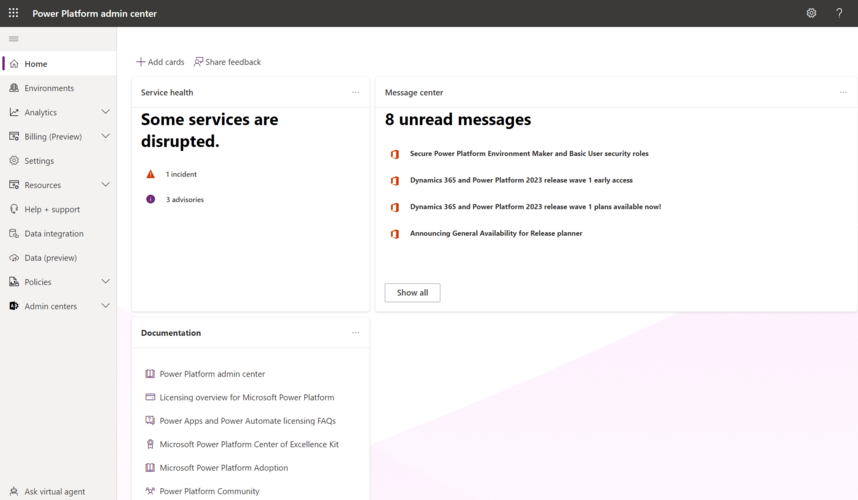If your organization has an Enterprise Microsoft 365 license, then it's likely that most employees have access to create Power Automate Flows & Power Apps. Both are standard features that are enabled for all employees by default. Users can find buttons to start or create applications and flows in SharePoint, Teams and even Excel. By default all available connectors are available as well, this includes connectors to social media such as Twitter but also connectors to personal storage like Dropbox. And that’s where some of the risk resides.
Some of our customers wanted more control over the services, so they could better understand the impact these have on the day-to-day operations. Let's take a look at why you might want to turn off these features and what options are available to exercise control in a more granular way.
Why Consider Turning Off Flow & Power Apps?
There are three common arguments for turning off Power Automate and Power Apps when organizations talk about deploying and managing these services:
- Increased impact on IT and support staff
- Critical business apps that are not developed by professional developers
- Loss of control by IT
Increased impact on IT and support staff
Businesses are concerned that there will be an increase in demand for support from the IT staff when everyone can freely create Flows and Apps. Naturally, if this happens without proper guidance and explanation, it is expected that the workload of the support staff will increase.
New questions will arise about these services, which will need answers, while the IT department may not necessarily be experts in these new capabilities. This will also lead to requests for applications built on this platform from departments that do not have the capability to develop them themselves.
Critical business apps not developed by professional developers
Getting started with creating a Flow or Power App is easy due to the huge amount of information available for self-learning. As a result, an employee can successfully create a simple app that can quickly become popular. Before you know it, this evolves into a critical business application for which the IT department is expected to provide support and maintenance. Such simple apps typically do not go through the classic development life cycle with thorough testing, version control, etc. If something goes wrong in the application, the long-term impact can be significant.
Loss of control by IT
In a standard situation, without any adjustments, all Flows and Power Apps are stored in the default environment. Anyone who tries to create a Power App or play with Power Automate will therefore store their data in the same environment. This eventually leads to a bloat of Flows & Power Apps, making it unclear which ones are experiments and which ones are actually being used to support business processes.
Reality Check: What happens when you turn off access?
Turning off access to Power Automate and Power Apps is an understandable, but perhaps extreme, response to the above pain points. Turning off one service does not necessarily mean turning off the other. By limiting the access to these services, you also limit their potential benefits, such as increased efficiency and productivity, streamlined processes, and improved collaboration. When employees have a need, they will look for a solution, using technology they already know to streamline their daily activities.
Perfect examples of this are Microsoft Access and Microsoft Excel. Employees use them to create simple apps: from simple forms to complete administrative processes. A large part of these Excel files contain business data, business processes, rules, logic, and calculations. The spreadsheets are usually not centrally stored or managed, and they are loosely shared among the involved employees.
When something goes wrong here or when the author leaves the organization, the IT department is looked at to take control of the situation. IT departments usually have no clear visibility into the number of Access databases and Excel files in circulation within the organization and which ones are important to the employees.
With Power Platform solutions it is possible for your IT department to get an overview of the applications and automations developed by employees and which ones are actively used and important for the day-to-day activities.
Do it right: Enable and exercise control
The Power Platform Admin Center offers several options for exercising more control over the applications that are created. Administrators get an overview of all Flows & Power Apps within the organization, with the corresponding statistics. They can also set up data policies, which regulate the connectors better. This way, they can make sure that some connectors cannot be used, or that a combination of connectors is not possible within the same Flow or Power App. For example, by not combining the Outlook and Dropbox connector, this blocks the ability for users to automatically send emails to Dropbox.
Another, particularly important functionality is the ability to create different environments. Automatizations and Power Apps can be organized in several environments, with some being more controlled than others. For example, all self-created applications are in one environment, while the applications developed and supported by IT are in another environment.
The IT department therefore has every interest in convincing employees to convert their Excel and Access applications to Flow & Power Apps, so they get a better overview of what is going on within the organization.
A few more recommendations to better control or manage the Power Platform:
- Create subsets of employees with different access rights.
- Create a mechanism for granting access to Power Apps and Flow.
- Set clear expectations for support. For example: if employees create their own Power App or Flow without permission, it will not be supported by the IT department
- Delete solutions created by unauthorized authors.

Ready for a company-wide deployment of Flow & Power Apps?
It's a big shift for IT departments to give employees access to tools that were previously only accessible to professional developers. On the other hand, employees are already trying to solve their problems with tools like Access, Excel, and other cloud services, and these applications are much harder to control.
The management of the Power Platform is streamlined with management tools, templates, reports, and administrator connectors in the Power Platform Admin Center. Giving employees access to these tools can result in:
- Better utilization of business knowledge
- IT no longer being a bottleneck
- Better security for apps
- Improved accountability and transparency for each app
- The ability to clearly identify app authors
Of course, this doesn't happen overnight. Rome wasn't built in a day. Build up slowly, with the right guidance and step by step opening up to more users to achieve a successful result. And don’t forget, if you need guidance during this transition, Qubix is here to help your organization achieve its Power Platform goals!











